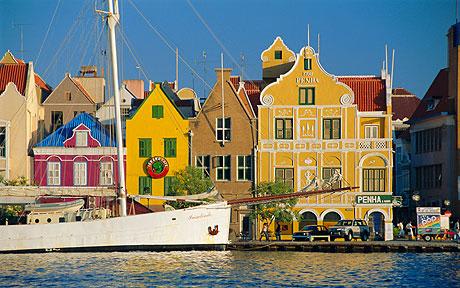Last winter I had the pleasure of visiting the Dutch-influenced Caribbean island of Aruba.
It is situated about 15 miles off the northern coast of Venezuela, but belongs to the group of islands known as “The Netherlands Antilles” which includes Aruba, Bonaire and Curacao, also known as the ABC islands.
It is a very warm climate with a temperature range from 82 – 92F all year round. The climate is very dry and with the constant trade winds that bring a nice breeze it could not be more perfect. It also lies outside the Hurricane belt and gets less than 24 inches of rain per year, so you’re pretty much guaranteed a beautiful day.

The Divi Tree
Its roots are a mix of Spanish, British and more recently Dutch, to whom it still belongs (although independent it is ruled by the Dutch government). The two official languages are the Dutch language and Papiamento. Papiamento is a language that has evolved through the centuries and absorbed many words from other languages like Dutch, English, diverse African dialects, and most importantly, from Portuguese and Spanish. However, like many islands in the region, Spanish is also often spoken.
The famous emblem of Aruba is the Divi Tree, which adorns many pictures and postcards. Because of the constant trade winds blowing, the branches and leaves normally sit to one side , making for a unique tree.

Dutch influenced architecture, with an island touch in the brightly colored buildings.
The Dutch influence can be seen in the buildings of the Capital city Oranjestad (orange town). They are very similar to the buildings you see in Amsterdam, tall and narrow, but here they are very brightly painted.

Aruba synagogue
There is one Synagogue in Aruba called the Beth Israel Synagogue. Jews, mostly merchants, arrived in Aruba at the beginning of the 20th century, when the oil refinery drew people from the Caribbean and Europe. The Jewish population today is small, but this synagogue endures with a membership of about 35 families. Most congregants at Friday night services are visitors, tourists on vacation. The synagogue is Conservative in style with full participation of both men and women. The small gift shop has one of a kind Aruban Judaica.

Dutch influenced architecture, with an island touch in the brightly colored buildings.
The grocery stores stock many products from the United States so getting kosher food is not a problem, but there is no meat or breads visible, although there was supposedly a kosher store (Kineret Aruba Glatt Kosher Deli at the Playa Linda Beach Resort, amidst the high-rise resort hotels) but rumor has it that it as closed.
The words of this author reflect his/her own opinions and do not necessarily represent the official position of the Orthodox Union.

